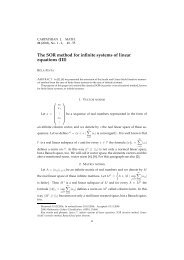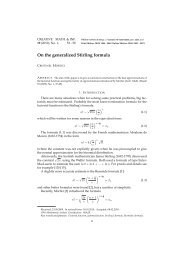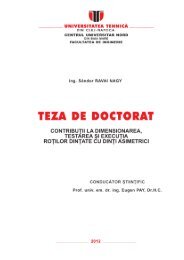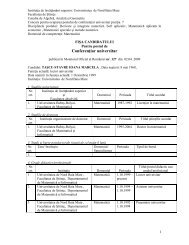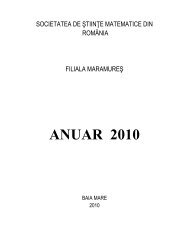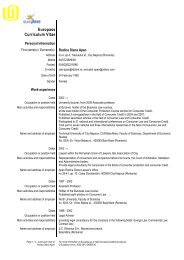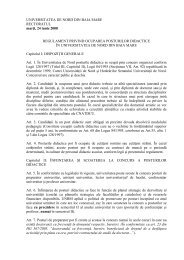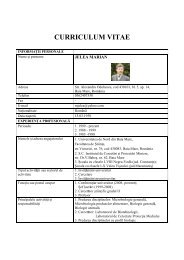Vol 3 (1) 2011 - UBM :: Departamentul de Chimie-Biologie
Vol 3 (1) 2011 - UBM :: Departamentul de Chimie-Biologie
Vol 3 (1) 2011 - UBM :: Departamentul de Chimie-Biologie
You also want an ePaper? Increase the reach of your titles
YUMPU automatically turns print PDFs into web optimized ePapers that Google loves.
H. El-Sayed M. Farag, Concentration of antibiotics residues in farmed tilapia and their relationship to resistant<br />
Aeromonas strains<br />
CONCENTRATION OF ANTIBIOTICS RESIDUES IN FARMED TILAPIA<br />
AND THEIR RELATIONSHIP TO RESISTANT AEROMONAS STRAINS<br />
Hassan El-Sayed M. Farag*<br />
Food Hygiene Dept., Animal Health Research Institute, Port-Said Lab., Egypt<br />
* has_far1@yahoo.com<br />
ABSTRACT<br />
Three groups of fresh tilapia, Oreochromis niloticus, were randomly collected from farms at Port-Said<br />
Governorate, Egypt for qualitative and quantitative <strong>de</strong>tection of antibiotic residues by microbiological assay method<br />
and HPLC. The sensitivity of isolated Aeromonas strains for oxytetracycline was also evaluated. The <strong>de</strong>tections of<br />
antibiotic residues in tilapia samples were found in a percentage of 100% (60), 80% (48) and 0.00% (0.00) for group<br />
I, II and III respectively. The <strong>de</strong>tected antibiotics were from the tetracycline and ß–lactam groups. The mean<br />
concentrations of the oxytetracycline residual level in tilapia muscle assessed were 319.92 ± 12.18, 142.14 ± 4.86<br />
and 75.49 ± 1.66 ppb for group I, II and III respectively. The isolated strains of Aeromonas species in the examined<br />
samples were various among the examined groups and phenotypic i<strong>de</strong>ntified as A. caviae, A. scubertii, A.<br />
hydrophila, A. trota and A. sobria. The inci<strong>de</strong>nce of oxytetracycline resistance Aeromonas strains in group I and II<br />
were 100% for each, while 35.71% of the isolated strains in the group III were resistant to oxytetracycline.<br />
Antibiotics residues are seemed to quality <strong>de</strong>fects in farmed tilapia that facing the challenges of the fish exporting in<br />
Egypt. Application of good manufacture practices and Hazards Analysis Critical Control System (HACCP) in tilapia<br />
farms must be done for improving the antibiotics residual problem in fish muscles.<br />
Keywords: Fish, microbiological assay, oxytetracycline, Bacteria.<br />
.<br />
1. Introduction<br />
Aquaculture has been consi<strong>de</strong>red one<br />
of the fastest growing segments of the global<br />
food production sector in recent <strong>de</strong>ca<strong>de</strong>s [1].<br />
In comparison to other farmed animals, fish<br />
are generally very efficient converters of<br />
feedstuffs into high quality protein [2].<br />
Tilapias, Oreochromis niloticus, have<br />
become the third most important fish in<br />
aquaculture that cultured in many tropical<br />
and subtropical regions. It is characterizes by<br />
high yields in a short period on relatively<br />
low nutritional inputs and high palatability<br />
[2].<br />
Member of the genus Aeromonas are<br />
ubiquitous in most aquatic environments<br />
through the world [3]. Several strains have<br />
been implicated in fish disease as<br />
Aeromonas hydrophila, A. Sobria, A.<br />
allosacchharophila, A. Salmonicida and A.<br />
veronii [4]. Aeromonas hydrophila is one of<br />
the most important agents of the outbreaks in<br />
fresh water fish, in which skin ulcer,<br />
44<br />
hemorrhage and necrosis of the visceral<br />
organs are the major symptoms of<br />
Aeromonad septicemia [5]. Diseases<br />
outbreaks due to Aeromonas species are<br />
responsible for high economic losses in both<br />
intensively and extensively cultured fish as<br />
well as in wild fish [6] as a result of high<br />
mortality and <strong>de</strong>terioration of product<br />
quality [7, 8 ]. Some strain of Aeromonas<br />
species such as Aeromonas hydrophila, A.<br />
veronii, A. jandaei, A. trota and A. schubertii<br />
have been emerged as opportunistic human<br />
pathogens [9] which responsible for<br />
foodborne gastroenteritis, pneumonia,<br />
peritonitis, endocarditis, meningitis,<br />
septicaemia, urinary tract infection and<br />
wound and skin infection specially in<br />
compromised patients [10, 11].<br />
The potential for disease problems<br />
associated with intensive fish culture would<br />
increase the probability of the use of<br />
antimicrobial drugs to treat a variety of<br />
bacterial infection [12] besi<strong>de</strong> promoting the



